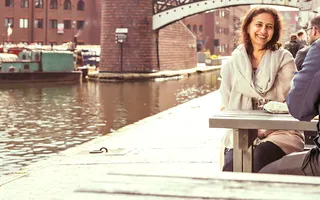There's something innately satisfying about the act of propelling oneself down a calm river in a little boat, and getting a duck's eye view of the water. But did you know there's a variety of ways you can paddle, depending on the vessel you're in? Let's take a closer look at some of them.
Different strokes for different folks
Do you know the difference between J-stroke and sculling? Read on for our guide to paddling strokes for kayaks, canoes, rowing boats, punts and coracles.

By Abi Whyte
J-stroke
The staple stroke for paddling a Canadian canoe, this nifty technique helps keep the boat on a straight path, even when the canoe has a natural tendency to turn. The stroke is so named because it draws a ‘J' in the water. You place the paddle vertically in the water, pull it back, then rotate the paddle 90° with your grip hand (the hand at the top of the paddle), pushing it slightly outwards with the other hand, thus creating the tail of the J.
Indian stroke
This movement provides the same propulsion as the J-stroke, but the paddle's blade stays submerged, making it a very quiet stroke: perfect for sneaking up on wildlife or spooking picnickers on the riverbank. It's also great in windy conditions, because steering is done throughout the stroke, and the paddle's blade, which has a large surface area, doesn't get buffeted around.
Rowing
So how easy is it to row, row, row your boat gently down the stream? For those familiar with canoeing, rowing can be tricky as you're sat facing away from the direction you're going, plus you're using two paddles instead of one (don't ever call them paddles to a seasoned rower, though!). It's important to remember to feather your oars when they're out of the water (turn them so they're parallel with the surface of the water, to decrease wind resistance), and when you're pulling them through the water, keep the paddle just below the water's surface – not too deep, as they'll be difficult to pull. To turn, you simply use one oar.
Sculling
This is the paddling technique for a coracle – a traditional fishing vessel made from willow, cow hide and tar. Coracles are notoriously challenging to manoeuvre, owing to their stout, round shape and lightness. However, once mastered, the figure-of-8 sculling movement at the front of the craft propels the coracle along fast-flowing streams and rivers in a lovely wiggling fashion. Sculling is also used by kayakers and canoeists to maneuver themselves alongside a mooring point or a fellow boater for that all-important river selfie.
Punting
Not so much paddling but sticking a 16ft pole into the water and pushing it against the river bed to propel you forwards on what looks like a long plank of wood. Punts – flat-bottomed, square-ended boats without a keel – were first used in medieval times for fishing, reed-cutting and transporting cargo on shallow waters, before ‘pleasure punting' began on the Thames around 1860. As well as for using the pole for propulsion, you also use it to steer the boat, applying it as a rudder.
Canoeing and kayaking on the Trust's waterways
Exploring our canals and rivers by canoe can help you get fit, closer to nature and allows you to experience our waterways from a totally new angle. Take a look at your guide to getting started.
Last Edited: 20 October 2022


Stay connected
Sign up to our newsletter and discover how we protect canals and help nature thrive



